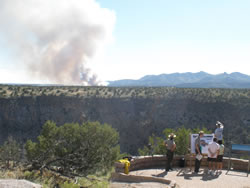
National Fire Plan Success Story
Cooperative Approach to Managing Fire
Bandelier National Monument, New Mexico
National Fire Plan - Accountability
2009

Park rangers used the San Miguel Fire as an opportunity to discuss and teach visitors about the ecological benefits of natural fire at the scenic overlook on the Monument’s entrance road.
The lighting-ignited San Miguel Fire started in early July 2009. From the beginning, Bandelier National Monument Superintendent Jason Lott and Santa Fe National Forest Supervisor Daniel Jiron agreed to work together to manage the fire for resource benefit as it progressed naturally from the Bandelier Wilderness into the Dome Wilderness on its western perimeter.
“The San Miguel Wildland Fire is an excellent example of our flexibility in managing wildfire,” said Incident Commander Robert Morales. “We were able to use a variety of tactics to limit the spread of the fire on a portion of the fire while continuing to manage the fire for resource objectives,” he added. As the fire progressed, hotshot crews and water-dropping aircraft were brought in to limit the fire's spread to the north, east, and south, where it had the potential to move into thicker fuels that would have burned hotter and faster than desired, and would have produced significantly more smoke that would have lasted for a longer period. “We focused our efforts on areas where firefighters could access the fire safely and where our resources would be most effective,” Morales said.
While smoke impacts were present during the San Miguel Wildland Fire, variable winds resulted in intermittent, temporary impacts to nearby communities during the most active days of the fire. “We always prioritize public health and safety when planning and managing wildland fire activities in the Monument,” said Superintendent Jason Lott. “We have a responsibility to balance short-term impacts with long-term benefits,” he added. Slow-moving, low to moderate intensity wildfires like the San Miguel Fire help reduce the future risk of large, destructive wildfires which can produce heavy smoke and impact communities for weeks.
The San Miguel Fire burned 1,635 acres (1,442 acres on National Park Service, 192 acres on U.S. Forest Service), and resulted in a mosaic of burned and unburned vegetation. Final costs for the fire are not available, but early estimates show the cost of managing the San Miguel Fire are hundreds of dollars per acre less than a comparable prescribed fire or a full-suppression fire.
Contact: Gary Kemp, Fire Management Officer, (505) 672-3861 ext. 550.